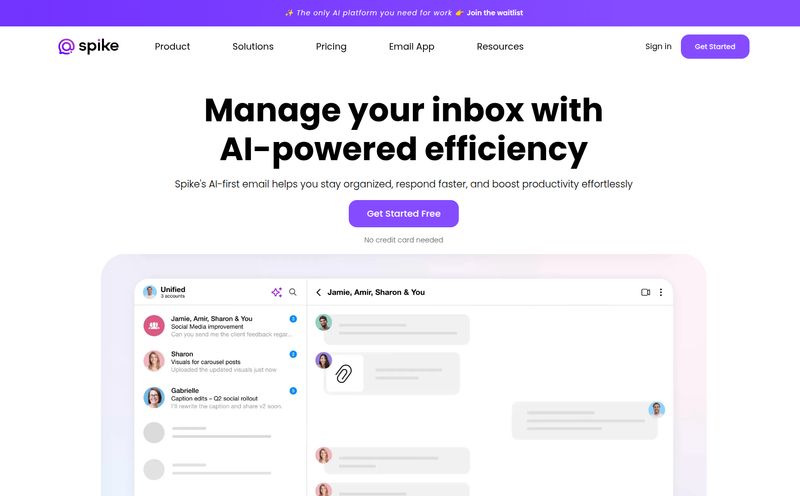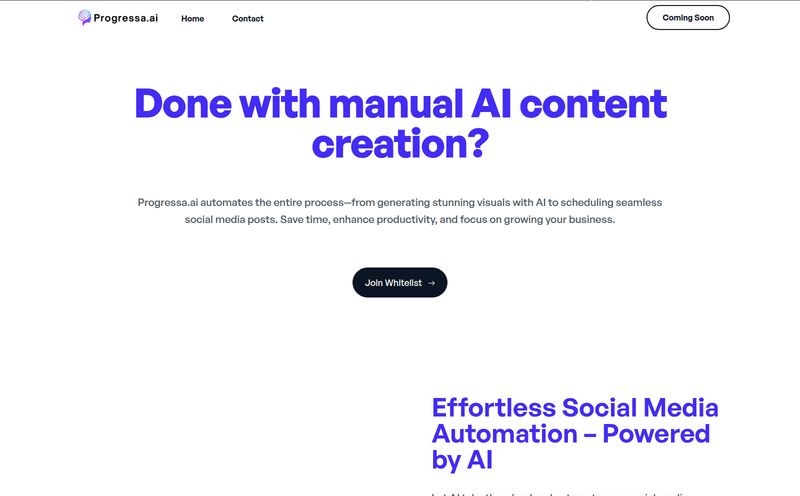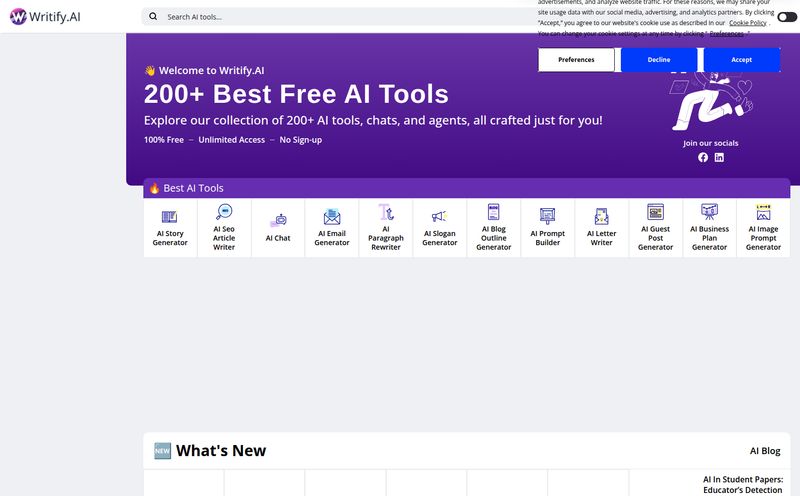I've been in the SEO and content game for a long time. I've seen trends come and go, from the keyword stuffing dark ages to the rise of semantic search. And now, we're in the age of AI. Every week, there's a new, supposedly 'game-changing' AI tool that promises the world. Most of them, if I'm being brutally honest, just give me a headache.
You know the feeling. Staring at a blank chat box, trying to conjure the perfect, multi-layered prompt that will hopefully, maybe, give you something usable. It's what I call "prompt paralysis," and it's a real productivity killer. So when I stumbled across a platform called LowTech AI, the name alone made me stop. Low-tech? AI? That's an oxymoron I had to investigate.
Is it possible to harness the power of artificial intelligence without feeling like you need a degree in computer science? Let's find out. Here’s my no-fluff, hands-on take on what LowTech AI is all about.
So, What Exactly Is LowTech AI?
At its core, LowTech AI is trying to do something I've been waiting for: make AI genuinely accessible. Forget wrestling with complex parameters or learning a new prompting language. The entire concept is built around a simple, fill-in-the-blank interface.
Think of it this way. Using a powerful model like GPT-4 directly is like being handed all the ingredients for a Michelin-star meal. You have everything you need, but you better be a world-class chef to pull it off. LowTech AI, on the other hand, is like a HelloFresh box. The ingredients are pre-portioned, the recipe card is dead simple, and you’re pretty much guaranteed a decent result without setting the kitchen on fire. It guides you. It holds your hand.
It's designed for writers, marketers, teachers, small business owners... you know, actual people who have jobs to do and don't have time to become full-time prompt engineers. You find a tool you need—say, a 'Tweet Generator'—and instead of a blank slate, you get fields like 'Topic:', 'Tone:', and 'Key Message:'. You fill them in, hit go, and get a result. Simple. Almost too simple.

Visit LowTech AI
My First Impressions (The Good Stuff)
The first thing that won me over? You can start using it immediately. No sign-up required. In an era where every site wants your email address just to show you the homepage, this is a massive green flag. It shows confidence in the product. They're saying, 'Go on, try it. We think you'll like it enough to create an account later.' And I respect that.
A Playground of Possibilities
Once you're in, you see a whole range of pre-built tools for summarizing articles, writing email copy, brainstorming ideas, and even generating simple code snippets. It's a real grab-bag of utility. I spent a good half hour just plugging in random ideas to see what would come out. I asked it to write a sea shanty about bounce rate and, you know what? It wasn't half bad. The quality is solid, especially for a tool that removes so much of the usual friction.
The Magic of Customization and Sharing
This is where LowTech AI gets really interesting. It's not just a collection of static tools. You can build your own. Let's say you're constantly writing meta descriptions for a specific type of product. You could create your own private tool called 'My Awesome Meta Description Writer' with fields for 'Product Name', 'Main Feature', and 'Target Audience'. You’ve basically created a custom-built AI assistant for your exact needs. Genius.
And then you can share it. With a link. This immediately got my agency brain buzzing. Imagine creating a custom tool for a client to help them draft their own social media posts, all perfectly aligned with the brand voice you established. No more messy spreadsheets or confusing instructions. Just send a link. That’s a powerful feature that many bigger platforms haven't quite nailed with this level of simplicity.
Let's Be Real: The Not-So-Perfect Parts
Okay, I'm a professional, which means I'm professionally skeptical. No tool is perfect, and LowTech AI has its own quirks. It's important to go in with your eyes open.
The Prompt Is Still King
Even though the interface is simplified, the age-old rule of AI still applies: garbage in, garbage out. If you put lazy, one-word inputs into the fields, you’ll get lazy, generic outputs back. The fill-in-the-blank system guides you toward a better prompt, but it can’t write it for you. You still need to provide quality source material. It lowers the barrier to entry, it doesn't eliminate it.
The Sign-Up Wall and the Mysterious AI Brain
Remember how I loved the no-signup-needed part? Well, the fun stops when you want to save one of those brilliant custom tools you built. To save or manage your creations, you'll need to create an account. This is standard practice, I get it. They have to make money somehow. But it's a classic freemium hook.
My other minor gripe is for the tech-curious folks like me. The platform doesn't say what AI model its running on. Is it GPT-3.5 Turbo? GPT-4? A custom-trained version of Llama 2? For the target audience of non-techies, this probably doesn't matter one bit. But for those of us who track the performance of different models, it feels like a bit of a black box. I’d love a little more transparency there, but it’s far from a dealbreaker.
Who Is LowTech AI Actually For?
After playing around with it, the ideal user profile becomes crystal clear. LowTech AI is not for the AI power-user who spends their evenings fine-tuning models on Hugging Face. It's for:
- Small Business Owners who wear 15 different hats and need to write a blog post, then an email, then a social media update, all before lunch.
- Content Marketers and SEOs who need to quickly generate ideas, outlines, or basic copy without getting bogged down.
- Teachers and Educators looking for easy ways to create lesson plans, quiz questions, or educational content.
- Anyone who feels overwhelmed by the complexity of other AI tools and just wants something that works.
It's for the doers, not the tinkerers. It's a daily driver, not a high-performance sports car you only take out on weekends.
What About the Price Tag?
Here's the million-dollar question. As of my review, there's no clear pricing page visible right from the get-go. The model seems to be a 'freemium' one—you can use the basic tools for free, but creating an account (which is also free) is required to save and manage your own custom tools. I suspect there will be a paid tier in the future, likely offering more credits, advanced features, or team collaboration. For now, the barrier to entry is effectively zero, which is fantastic.
Final Thoughts From a Jaded SEO Pro
So, is LowTech AI another piece of AI hype? I’m happy to report that, no, it's not. It's a genuinely useful, well-thought-out platform that solves a real problem. It successfully bridges the gap between the raw power of AI and the practical needs of everyday users.
It won't replace the deep, nuanced work that requires human expertise. It won't write a thought leadership article that'll win a Pulitzer. But for clearing out the underbrush of daily creative and administrative tasks? It’s an absolute gem. It's a cure for the dreaded "prompt paralysis" and a tool I'll genuinely keep in my back pocket for quick wins. And in this industry, sometimes a quick win is all you need.
Frequently Asked Questions about LowTech AI
- Do I need to be a tech expert to use LowTech AI?
- Absolutely not. That's the entire point of the platform. If you can fill out a simple online form, you can use LowTech AI. It's designed specifically for non-technical users.
- Is LowTech AI completely free?
- It appears to operate on a freemium model. You can use many of the tools for free without an account. To create, save, and manage your own custom tools, you'll need to sign up for a free account. Paid plans might be introduced in the future for heavier users.
- Can I create my own AI tools with LowTech AI?
- Yes, and this is one of its most powerful features. You can create custom tools with specific fill-in-the-blank fields tailored to your recurring tasks, and even share them with others.
- How does LowTech AI compare to something like ChatGPT?
- Think of it as structure vs. flexibility. ChatGPT is a wide-open conversational interface, which is powerful but can be intimidating. LowTech AI provides pre-built templates and a guided, form-based approach for specific tasks, which often leads to more consistent results with less effort. As one expert from Search Engine Journal might say, structured prompts often yield better outputs.
- Are the results from LowTech AI any good?
- Yes, for the most part. The quality of the output is heavily dependent on the quality of your input. The structured format helps guide the AI, but providing clear, detailed information in the fields will give you the best results.
Reference and Sources
- LowTech AI Official Website: https://lowtech.ai/
- Hugging Face Community: https://huggingface.co/
- Search Engine Journal - A Guide to ChatGPT Prompts: https://www.searchenginejournal.com/chatgpt-prompt-guide-for-seos/476988/



